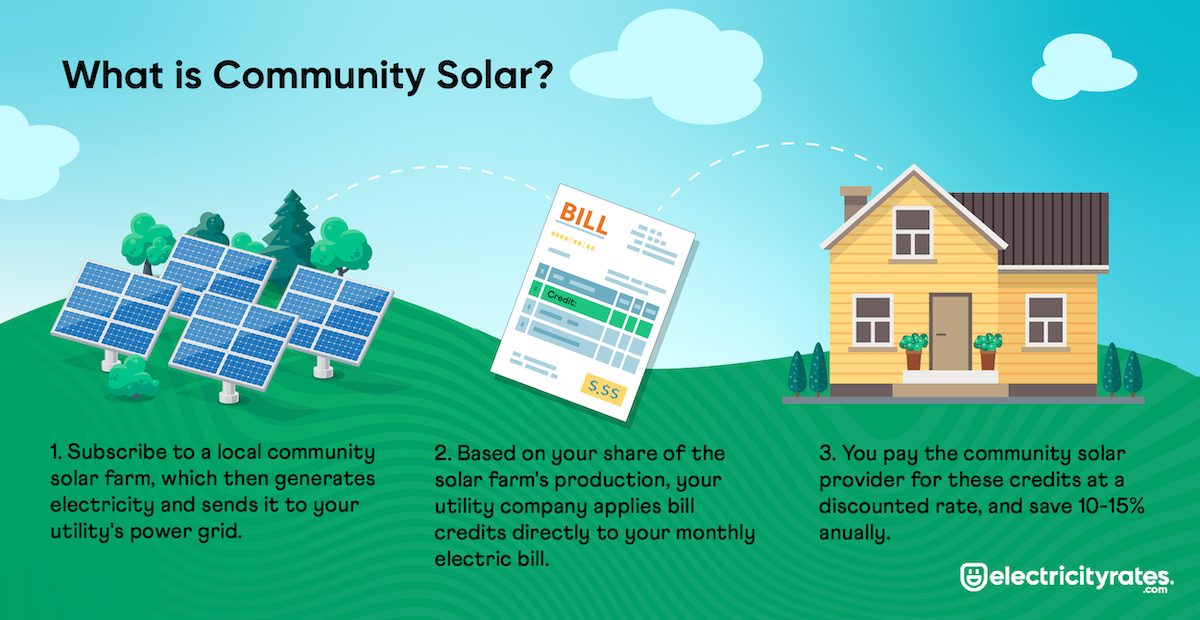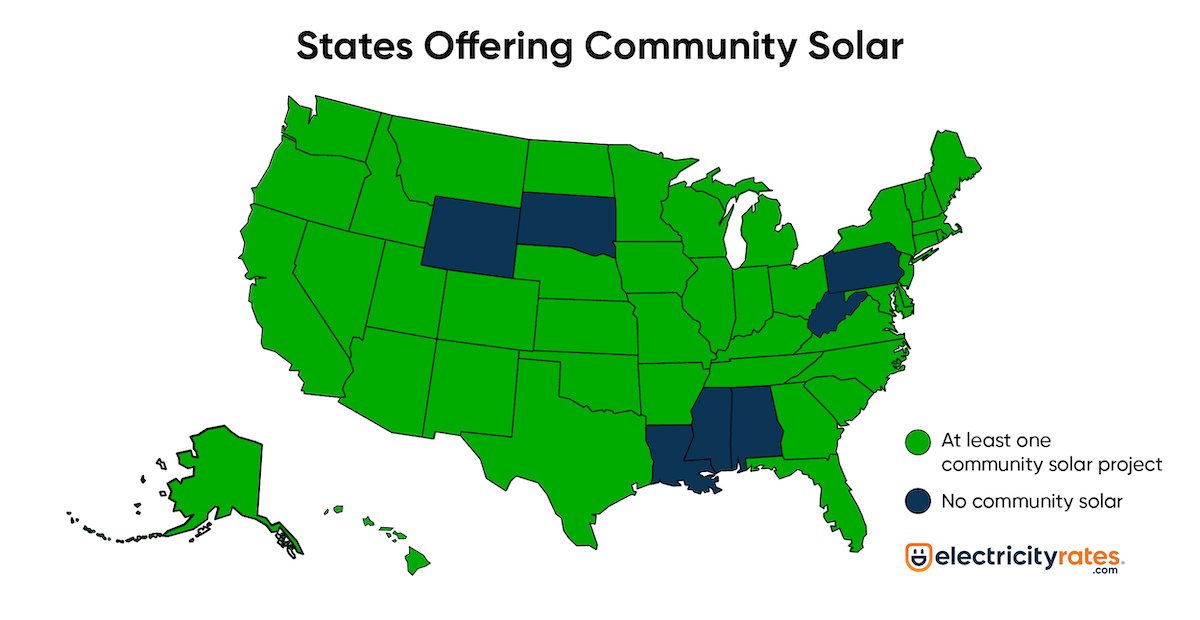The browser you are using is not supported. Please consider using a modern browser.

A Guide to Understanding Community Solar Programs
Key Takeaways
- Community solar provides a way to save money on electricity bills without installing rooftop panels. It allows people to subscribe to a share of a local solar farm's energy production and receive a discount on their regular utility bill, with typical savings ranging from 5% to 15%. This is especially beneficial for renters or those with unsuitable roofs.
- The process involves subscribing to a solar farm, receiving bill credits, and paying the provider a discounted rate for those credits. The solar farm sends power to the grid, and in return, the utility company credits your monthly bill. You then pay the community solar provider for the value of those credits, but at a reduced rate, which is how you save.
- Community solar is a legitimate and growing segment of the renewable energy industry. It helps reduce your carbon footprint, supports local clean energy development, and is often accessible to a wide range of people, including those in lower-income brackets, through specific state and provider programs.
Table of Contents

Are you curious about community solar programs? You’re not alone.
With the buzz around renewable energy getting louder, community solar is quickly becoming a popular choice across the U.S. But what’s it all about? Stick around as we unfold the nuts and bolts of community solar programs, weigh the pros and cons, and help you get started saving.
What Is Community Solar?
Ever wish you could tap into solar power without the hassle of installing panels on your roof? That’s where the magic of community solar comes into play.
The first community solar farms emerged in 2006, and today they are the fastest-growing segment of the solar industry. They allow everyone to benefit from solar power without installing panels or equipment.
Community solar is when a group of people shares electricity from a local solar farm. The model allows multiple customers, such as individuals, businesses, and nonprofits, to benefit from a solar project within a specific region. Customers subscribe to solar panels located off-site. They receive a credit on their electric bill for the electricity produced by the portion of the community solar they own.

How does community solar work?
- Subscribe to a community solar farm in your utility company’s territory.
- Receive a share of the solar farm’s emission-free solar power based on your electricity usage.
- The electricity is exported to the electric grid by your share of the farm.
- Pay your community solar provider for credit towards your electric bill, which is determined by the amount of electricity your share generates.
- Your utility company applies the bill credits to your monthly bill, reducing your charges.
Benefits of Community Solar
Community solar is making waves, and here’s why folks love it:
- Saves You Money: Community solar participants typically save between 5% to 15% on their annual electricity bills. The total amount saved will depend on a number of factors, including residential vs. commercial plans, total energy used, and geographic location.
- Eco-Friendly Energy Source: Joining a community solar project slashes your carbon footprint. Community solar projects significantly reduce greenhouse gas emissions. According to a report by the Environmental Protection Agency (EPA), every megawatt-hour (MWh) of solar power generated through community solar can offset approximately 0.9 metric tons of CO2 emissions, contributing to cleaner air and combating climate change.
- No Rooftop, No Problem: Solar community projects require no equipment at your home. This feature is particularly beneficial for individuals who rent their homes or live in areas where rooftop solar is not feasible due to cloudy weather, roof conditions, or home ownership association issues.
- Legitimate and Accessible for All: Whether you’re a renter or live in an area not suitable for rooftop solar, community solar is a great option for all income levels. For example, Colorado’s community solar programs are designed to be inclusive, offering subscriptions to a diverse demographic, including low and moderate-income households. Community solar is becoming increasingly available across the entire country.
- Supports Local Projects: By participating in community solar, individuals contribute to the development of local solar projects. This support not only boosts the local economy but also creates jobs, improves regional energy stability, and promotes sustainability. New York has confirmed it’s position as the leading community solar market in the U.S. with a new two-gigawatt community solar farm. The Empire State has nearly one-third of the nation’s 6.2 GW of community solar capacity.
The Environmental Impact of Choosing Community Solar
-

Opting into a community solar program produces no greenhouse gas emissions and is equivalent to taking 4 cars off the road.
-

Improves air quality and human health, resulting in a 6% reduction in hospital visits due to respiratory issues.
-

Reduces dependence on fossil fuels, resulting in 50% less carbon dioxide emissions, and helps mitigate the negative impacts of climate change.
-

Preserves natural resources and wildlife habitats by avoiding the need to extract fossil fuels. Results in 8,415 lbs of coal not being burned into Earth’s atmosphere.
Data provided is based on annual electricity usage of 10,500 kWh per year.
Illuminating Your Decision: Is Community Solar Right for You?
Evaluating whether to participate in a community solar program requires careful consideration:
- Verify Eligibility: Confirm your eligibility for community solar programs, as they may have specific requirements. Typically, you only need to subscribe to a utility provider to get started.
- Analyze Energy Usage: Assess your household’s energy consumption to determine if community solar aligns with your needs.
- Review Contract Terms: Understand the terms and duration of the community solar contract before committing.
- Evaluate Cost Savings: Calculate potential savings against current electricity expenses to gauge financial benefits.
- Consider Longevity: Factor in the long-term perspective, ensuring the program complements your future energy plans.
A step-by-step approach will help you make an informed choice on the suitability of community solar for your energy requirements.
Community Solar Vs. Green Energy Plans
When choosing between community solar or green energy plans, keep in mind a few things. Community solar means everyone helps pay for a solar farm nearby. Green energy plans might use wind or water power, too. Community solar can cost less, and you don’t have to change anything at home. Plus, you support local renewable companies.
Green plans mix different clean energy sources. Many electricity providers now offer renewable plans with zero emissions as well. Think about what matters to you – community solar is all about local solar, while green plans offer variety. Both are great for the planet and cost the same or less than traditional sources of electricity.
Community Solar Vs. Rooftop Solar
Rooftop solar systems require homeownership and a significant upfront investment. They offer personal energy production and the potential for increased property value. In contrast, community solar is an accessible alternative that doesn’t require property ownership, upfront costs, or suitable roofing conditions. It is more inclusive and appeals to a broader range of people.
With community solar, participants share the energy production, contributing to sustainability without the logistical and financial commitments of rooftop installations. The decision between the two options depends on individual circumstances, such as financial readiness, property suitability, and personal preferences for energy independence or community participation. Both choices promise to use renewable energy but cater to different needs.
Choosing Your Solar Squad: What to Look for in a Community Solar Company
When picking a community solar farm, a few tips can help you make the best choice:
The ownership model allows customers to buy a share of the solar array, providing them with a more direct stake in the project’s output and potentially greater savings. Generally, ownership often requires a larger upfront investment but may yield higher long-term returns in some states with big tax incentives and plentiful sunshine.
Is Community Solar Available In My State?
If you’re searching online for ‘solar fields near me or solar projects near me,’ you have come to the right place.
Community solar is popping up all over the U.S., but not all states are on the same page. Currently, it’s available in 44 states and D.C.


How to Sign Up for Community Solar
Signing up for community solar is easier than you might think:
- Enter your ZIP Code on our Marketplace to see a list of nearby farms.
- Compare solar project details like location, savings, status, credit requirements, and cancellation terms. Click on a project to learn more about its size, availability, billing, and sign-up bonuses.
- Choose an offer and fill out a form with basic info, utility account number, and about a year of electricity usage. A credit check may be required.
- Finalize your subscription with your provider. They’ll allocate a share of the solar farm based on your consumption. This share will meet 85-90% of your annual energy needs.
- Wait for 1-3 months to see credits on your bills and receive an invoice from your usual utility company. Your utility company works with your provider for billing setup. Some projects require a minimum number of subscribers, which may delay your savings.
Community Solar Providers
The role of a community solar provider is to connect you with local community farms in your area. The core service they provide is a subscription-based model that streamlines the enrollment, billing, and customer service tasks that come with customer acquisition.
Perch Energy
Perch Energy brightens the community solar landscape with equal access to clean energy. They democratize the benefits of solar power, allowing renters, homeowners, and business owners alike to tap into solar farms without on-site installation. Their model focuses on sustainability and offers noticeable savings on electricity bills through clean energy credits.
- Product Offering 5/5: Perch Energy manages over 150 solar farm projects and steers more than $28 million in discounts to subscribers. Proving its promise of affordable and renewable energy solutions.
- Customer Support 4.5/5: With an easy-to-use platform, they ensure subscribers benefit from solar credits and can reach out via chat, phone, or email at any time.
- History and Outreach 5/5: This community solar company is a certified B Corporation with over 26,000 subscriptions. Perch’s mission is to make green energy universally accessible with a deep commitment to the community and planet.
- Customer Reviews 4/5: Perch Energy is certified with the Better Business Bureau, and with their rapid growth, it is clear that customers can’t get enough of this community solar provider.
Currently, Perch Energy provides community solar programs in Massachusetts, Delaware, New Jersey, Maine, Maryland, Washington D.C., New Mexico, Illinois, and New York.
Nexamp
Founded in 2007 by two U.S. Army veterans, Nexamp has grown from a solar installer into a leading community solar company. Its mission is to make clean energy affordable and accessible by developing and operating large-scale solar farms.
- Product Offering 5/5: Nexamp offers integrated advanced energy storage solutions and is expanding its community solar model into new markets to help a broader range of customers access renewable energy.
- Customer Support 4.5/5: This community solar provider offers high support through blog articles, easy customer support channels, and additional resources.
- History and Outreach 5/5: Nexamp has collaborated with state and local governments to remove barriers to entry for lower-income communities, implemented green best practices, such as recycling programs for construction waste and the retirement of solar panels.
- Customer Reviews 4/5: Nexamp has been featured in PV Magazine USA, Solar Power World, and Electrek, which specialize in the clean energy and solar industries. They have earned a 4.5-star review on Trustpilot, highlighting how powerful their tools for billing and utility usage data are for saving money and energy.
Nexamp has a growing national footprint, with projects and service areas across the United States. They have a particularly strong presence in the Northeast, including Massachusetts, Rhode Island, and New York, but have expanded into other states like Illinois and Maryland, with new projects and markets continually in development.
What to Expect With Your New Solar Bills
The most confusing aspect of a community solar program is that most customers will now receive two bills. One from your utility and one from your community solar provider.
With community solar, you will be required to pay for a percentage of the credits based on the energy production of your solar farm. But it is important to note that you will pay less than what your credits are worth (less than the discount you got off of your utility bill) and credits are not seen until 1-3 months after your bill.
For example if you earned $100 credit discount off of your April utility bill, you will pay your community solar provider for 90% of that, or $90 in June. The community solar provider passes along that money to the solar farm owner and you net out with $10 savings just not during the same month.

This example bill scenario is for a resident on a 10% savings project. Savings rates will vary by state and eligibility factors.
In most states, you will pay your community solar provider 1-3 months after your utility bill. In certain states, payment will happen directly through your utility bill. So check your contract for these state-specific details.
How to Find and Compare Community Solar Near You
The best way to find community solar projects is to enter your ZIP Code in our search bar. You will be able to compare community solar plans near you and find one that fits your needs. Easily compare what each program offers, like savings and contract terms, to find the best fit for you.
Remember, community solar is a great way to support renewable energy and save on your electricity bill, all without the need to install any equipment at your home. It’s a win-win for you and the planet.